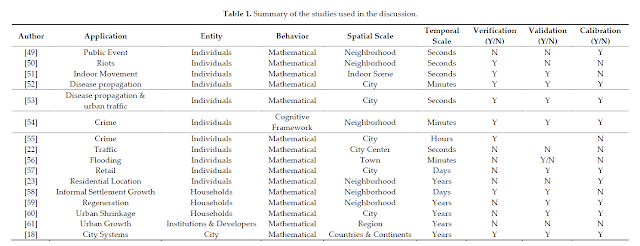Recently, Alison Heppenstall, Nick Malleson and myself have just had a paper accepted in Systems entitled: “Space, the Final Frontier”: How Good are Agent-Based Models at Simulating Individuals and Space in Cities?” In the paper we critically examine how well agent-based models have simulated a variety of urban processes. We discus what considerations are needed when choosing the appropriate level of spatial analysis and time frame to model urban phenomena and what role Big Data can play in agent-based modeling. Below you can read the abstract of the paper and see a number of example applications discussed.
Abstract: Cities are complex systems, comprising of many interacting parts. How we simulate and understand causality in urban systems is continually evolving. Over the last decade the agent-based modeling (ABM) paradigm has provided a new lens for understanding the effects of interactions of individuals and how through such interactions macro structures emerge, both in the social and physical environment of cities. However, such a paradigm has been hindered due to computational power and a lack of large fine scale datasets. Within the last few years we have witnessed a massive increase in computational processing power and storage, combined with the onset of Big Data. Today geographers find themselves in a data rich era. We now have access to a variety of data sources (e.g., social media, mobile phone data, etc.) that tells us how, and when, individuals are using urban spaces. These data raise several questions: can we effectively use them to understand and model cities as complex entities? How well have ABM approaches lent themselves to simulating the dynamics of urban processes? What has been, or will be, the influence of Big Data on increasing our ability to understand and simulate cities? What is the appropriate level of spatial analysis and time frame to model urban phenomena? Within this paper we discuss these questions using several examples of ABM applied to urban geography to begin a dialogue about the utility of ABM for urban modeling. The arguments that the paper raises are applicable across the wider research environment where researchers are considering using this approach.
Keywords: cities; agent-based modeling; big data; crime; retail; space; simulation
 |
| Figure 1. (A) System structure; (B) System hierarchy; and (C) Related subsystems/processes (adapted from Batty, 2013). |
Reference cited:
Batty, M. (2013). The New Science of Cities; MIT Press: Cambridge, MA, USA.
Full reference to the open access paper:
Heppenstall, A., Malleson, N. and Crooks A.T. (2016). “Space, the Final Frontier”: How Good are Agent-based Models at Simulating Individuals and Space in Cities?, Systems, 4(1), 9; doi: 10.3390/systems4010009 (pdf)
Continue reading »
![]()



















